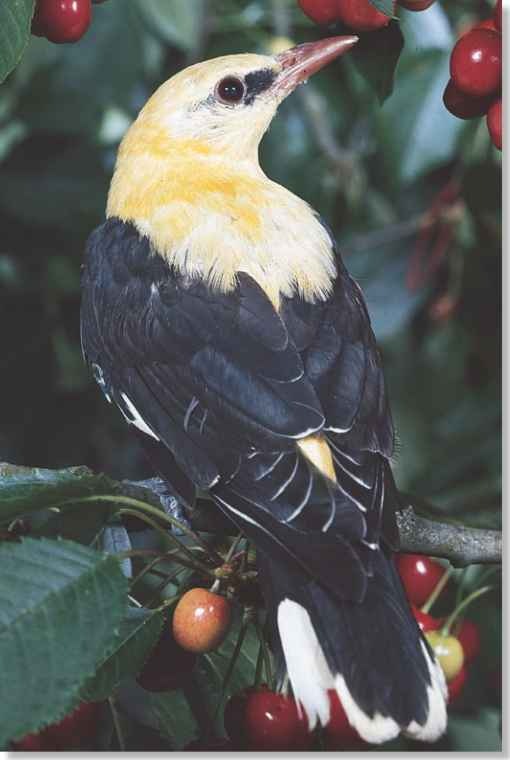ORDER
Passeriform.es
FAMILY
Oriolidae
GENUS & SPECIES
KEY FEATURES
• Hides amazingly well in the dense J foliage, despite its brilliant yellow feathers
• Reveals its location
with a characteristic whistling song
• Migrates thousands of miles each year
to avoid the harsh winters of Europe and Asia
• Female builds -a neatly woven, hammock-style nest
WHERE IN THE WORLD?
Breeds throughout Europe and parts of Asia, including England, Germany, \ France and Greece; migrates to parts of central Africa, as far south as Kenya and Tanzania for the winter

Lifecycle
Despite its bright colors, the golden oriole is more commonly heard than seen; its flutelike, whistling song signals the start and finish of the day.
Habitat

A secret forest
Dense foliage provides good hideouts for the oriole.
The golden oriole is the only European oriole. Widespread across Europe and Asia during the breeding season, the golden
oriole nests in older deciduous forests and large parks where the dense foliage provides ample camouflage for the shy bird. The broad-leaved trees provide fruit and berries and attract insects for the adults and chicks, as well as protective nesting sites. In England, the bird limits itself exclusively to black poplar plantations.
The golden oriole migrates south for the winterThe birds form small clusters and even congregate into vast flocks to begin their journey in August. The island of Cyprus is one of many stops midway between its summer and winter homes.The birds rest from a few days up to a week before continuing their travels to Africa.
Conservation
The golden oriole is not currently threatened; it remains common and widespread throughout Europe and Asia, wherever there is dense forest cover. But habitat destruction is an impending threat as older forests are cut for human use. Pesticides also pose a threat to this tree-dwelling bird.
# The golden oriole is not closely related to the orioles of the Americas, which are in an entirely different family, Emberizidae.
# When adding fat reserves for its long migration, the golden oriole will fly up to a mile in search of carbohydrate- and calorie-rich fruits and berries.
Behavior
The golden oriole’s flutelike, whistling song is often the only sign of its presence. The bird sings its fast, clear choo-klee-klooee in the early morning and evening from its hidden, treetop retreat. The oriole is solitary, but not territorial; it tolerates the presence of other birds. It can be seen flying to a new fruit tree or descen to the ground where, no long! camouflaged in the trees, its brilliant golden feathers shine in the sunlight. The bird rarely flies far during / the breeding season; most flight is limited to the long-distance migrations.
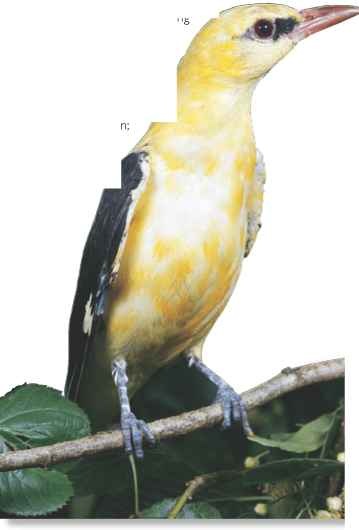
Alone The solitary oriole remains hidden for most of the day.
Breeding
The return of the golden oriole migrants in April signals the start of the breeding season. With its pointed wings and short tail, the male golden oriole pursues the female during high-speed courtship chases. These ritual chases offer a rare glimpse of the birds before they retreat to their secluded nesting sites. The female builds a distinct hammocklike nest, weaving grasses, moss and lichens into a deep, protective basket suspended between a slender tree fork. She lays 3-4 white eggs with small blackish spots.The male then assists the female during a 2-week long incubation period, relieving the female while she feeds. The nestlings are fed insects by the parents and quickly mature; they are able to fly in about 14 days. Male juveniles are almost indistinguishable from females, since they do not yet have the brilliant golden plumage.
Me first The male brings food to the anxiously awaiting chicks and female.
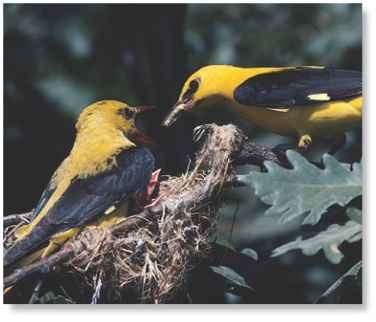
Food & feeding

The golden oriole’s feeding movements are slow and deliberate; it carefully searches high and low for caterpillars, which form the bulk of its diet. An opportunist, the oriole will settle for other insects, which it plucks from branches, or small vertebrates, such as mice. In the autumn, the bird switches its focus to fruits and berries, adding fat reserves in preparation for a long migration south. The bird occasionally descends to the ground to feed on fallen berries or crawling insects.
GOLDEN OPPORTUNITIES

Pluck…
A male golden oriole holds firmly to his perch and stretches out to reach a favorite insect, a slow-moving hairy caterpillar.
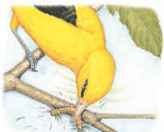
Beat…
The bird swings its head up and down, side-to-side, beating the insect to remove its irritating hairs before swallowing it.
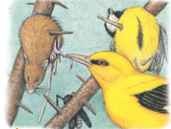
Raid…
Making sure the coast is clear, it picks at a mouse found in the food cache of the shrike, a highly territorial bird.
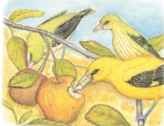
Bite
A male is joined by his two offspring as they fatten up on fruits before beginning their journey south.
PROFILE
Golden Oriole
The male golden oriole has stunningly colorful plumage, but he blends surprisingly well in his treetop home with his less-colorful mate.
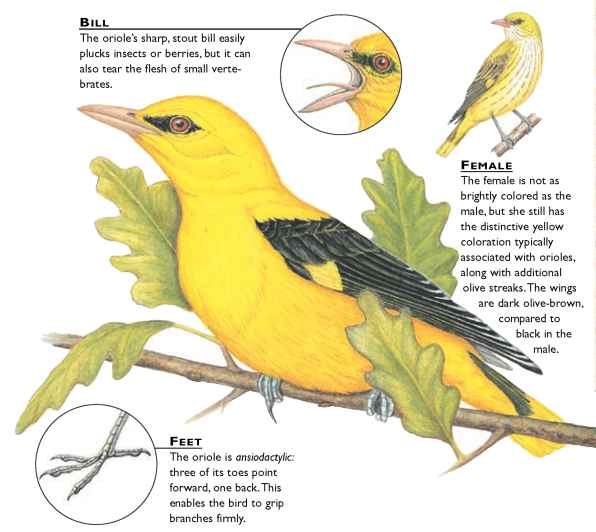
Creature comparisons
The African golden oriole (Oriolus auratus) is slightly smaller than the golden oriole. Both species are remarkably similar in coloration, but the African golden oriole has golden-yellow wing feathers mixed with the black and a larger black eye streak than the golden oriole. When the golden oriole migrates south for the winter, both birds can be seen in some of the same regions of Africa. The African golden oriole feeds in trees, while the golden oriole will occasionally be seen searching the ground for insects or fallen berries.

Golden oriole
| VITAL STATISTICS | |
| Weight | About 2.3 oz. |
| Length | 8.25-10″ |
| Sexual Maturity | 1 year |
| Breeding Season | .April-July |
| Number of Eggs | 3-4 |
| Incubation Period | 14-15 days |
| Fledging Period | 14-15 days |
| Breeding Interval | 1 year |
| Typical Diet | Insects, including caterpillars, small vertebrates, fruits and berries |
| Lifespan | Unknown |
RELATED SPECIES
• The golden oriole’s genus, Oriolus, contains over 20 species of oriole, and is one of two genera in the small family Oriolidae. The other genus, Sphecotheres, consists of figbirds, including the yellow figbird, S. flaviventris. Overall, figbirds have subtler shades of olive green, gray and yellow than orioles have. Figbirds and orioles join other perching birds in the order Passeriformes.
